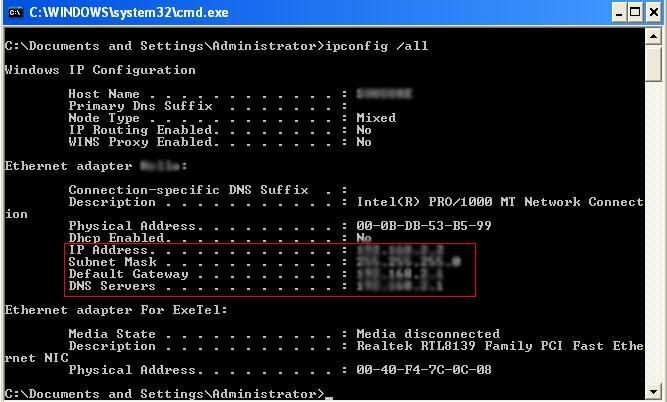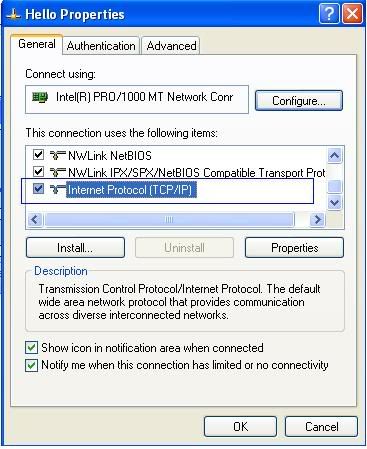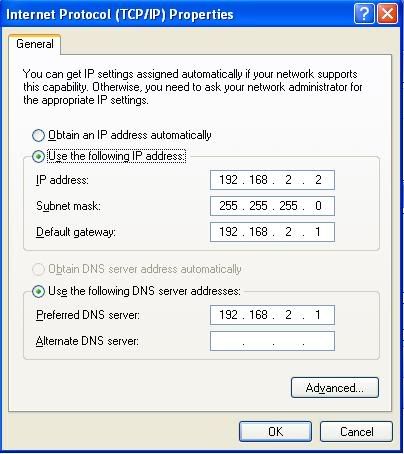OR
To check whether you have a MODEM or a ROUTER, follow these instructions below:
- Click on Start ---> Run ---> type cmd -> press enter or OK ---> type ipconfig -> press enter
- Have a look at your IP address and Default Gateway numbers.
- If these numbers are different [i.e. Gateway: xxx.xxx.x.1 & IP address:xxx.xxx.x.2] then you have a Router
OR - If these numbers are exactly the same, then you have a Modem and you don't need to read this guide
As this topic is reserved for teaching users on how to Port Forward and set up their static IP, you may read up on more info regarding Routers here -> http://www.devhardwa....er-Overview/1/
Now, enough chat, and onto the actual steps!
- Firstly, no matter which Brand your router is, you will need to set up a static IP on the PC that will be using BitComet. By setting a static IP, you are forcing your router to always give your PC the same IP Address. If you dont do this then every time you restart your PC it may have a different IP Address which is undesirable for portforwarding.
Click on Start ---> Run ---> Type cmd -> press enter or OK ---> type ipconfig/all -> press enter
Then you should see a brief flick of your MS-DOS, and about 6-8 lines popping up:
Copy the items you see in the red boxed area: -
IP Address:
SubNet Mask:
Default Gateway:
DNS Servers: (I only have one, but some users may have 2, be sure to copy both of them!) - Next, click on Start ---> My Network Places. Under Network tasks on your left panel, click on 'View Network connections'. Now, this is the slightly hard part, locate the network that YOU use to access the internet.
[If you're unsure, try disabling one of your network connections seen in that window, then open up your browser. The one that disables your internet connection is the network connection you use to connect to the internet. If you're unsure of this step, post in Torrent Related Questions/BitComet client help, and I'll help you out] - Once you've located it, double-click that connection, click Properties --> Scroll down the window till you locate Internet Protocol TCP/IP.

- Next, click Properties, and an extra window should pop-up. As shown below:

Next, Click: use the following IP Addresses. Here input what you saw in the MS-DOS command window when you typed in ipconfig/all
The DNS server addresses will be entered separately, click Use the following DNS server addresses, and input your DNS server(s).
Once you've done that, click Ok, then Close. - Next, Head to http://www.portforward.com/routers.htm and locate your Router model/brand or one similar. Then, locate BitComet, and follow the instructions onscreen.
- When you come to the step where it states "Please enter the static ip you want to forward to:" And it's 192.168.2.[space here] Input the last digit of your IP address into the space. The Static IP is the same IP Address as the one you saw in MS-DOS when you typed ipconfig/all
Speed maximization tip: If you wish to maximize the speed attained through BitComet, please use any single port between 49152 to 65534. Input the port number into BitComet's listening Port tab.
Once you've completed the steps at Portforward.com Your BitComet client should now be functioning at its maximum capability. Just a reminder, the port you configured with YOUR router, is the port that must be input into BitComet. [Options --> Preferences --> Choose Listening Port ]
Further Information:
The following are common IPs for different routers that you will need to input into your web browser in order to access your Router's setup page within the PortForward Step.
These are just common IPs, your router's IP may be different which you can check using ipconfig.Asus, Draytek, Linksys, Zyxel, Cisco, WooWeb-Pro
http://192.168.1.1/
Belkin, SMC (some browsers need :88 added)
http://192.168.2.1/ (http://192.168.2.1:88)
DLink, NetGear, Nexland
http://192.168.0.1/ - If you want to check whether your Port is open or not (in other words, checking if your portforward worked), head to: https://grc.com/x/ne.dll?bh0bkyd2
And click Proceed --> Type the Port you're using in BitComet, and click 'User Specified Custom Port Probe'. In the results, if it says that the port is Open, then you're all set!
Your BitComet should now be functioning properly. Remember though, even if you're not a Router-user, you will need to specify the Ports you want your BitComet to use. Should your port state it's in stealth or CLOSED, then it's more than likely that during your Portforwarding Process something went wrong...or even, you may have accidentally forgotten to press update or enable. If you've checked your steps, and everything was okay, yet you're encountering this issue, please post your problem at Torrent Related Questions or BitComet Client Help. - Once you've checked your port is OPEN, then your torrent speeds should begin to pick up pace. Please do not use the "Do you see Local or Remote Iniatiation Peers" Point that was described in the old BitComet FAQ, this is highly inaccurate, because depending on the torrent you're downloading, you can get all local peers, or all remote peers. E.g. If you're living in USA, and you're downloading a japanese torrent, your peer initiations are more than likely to be all Remote, you may also find that alot of Japanese torrents use BitComet.
- NOTE: Alot of people who have read BitComet Speed FAQ Guides may have also come across the issue of Windows SP2 users having a maximum of 10 TCP/IP users per second, which some believe may limit their download capability for BitComet. This is however untrue, as Dark Shroud pointed this out, this TCP/IP limitation has negligible effect upon the ports, connections. The lvllord patch hosted at this site:
www.lvllord.de
is No longer updated Thus, installing this patch will not improve your download capability. For a full explanation of why users SHOULD NOT install this lvllord patch, please read the extensive explanation written up by Dark Shroud:Quote
That limit of 10 incomplete outbound TCP/IP connections per second. It is not a limit on ports, complete connections, nor does it drop or block connections. The connections past 10 are put into a queue or put on hold. Meaning when one connection is either completed or timed out it moves onto the next waiting connection. So once again I will say no connection is dropped, blocked, or lost. This limit only affects connecting to other clients, not the actual downloading of data from them. If you're on a proper high speed connection you will not even notice this because it only slows you down by a matter of seconds when the .torret is started. Just leave BitComet's limit of 8 alone and you'll still be able to web surf while using BitComet, after all you want to leave your browser to slots to connect to web pages.
This was put in place to help prevent the spread of worms like Blaster and hinder a computer's use in performing DOS attacks.
This does not affect any type of DHT connection for any of the p2p programs that use DHT. Because DHT uses UDP for connecting, this is not limited in any way other than the speed of your connection. So just use DHT at start up and you'll be fine.
And on top of all the people who do not know what they're talking about in regards to that "patch" it is very outdated so it screws up your internet connections. If you're using Media Center Edition it will kill your connection all together and you'll need to do a system restore to fix the damage.
Thanks For This Its Awsome Share
ReplyDeleteWorldfree4u.me
Am SO Happy Today
ReplyDeleteWorldfree4u.info
Worldfree4u